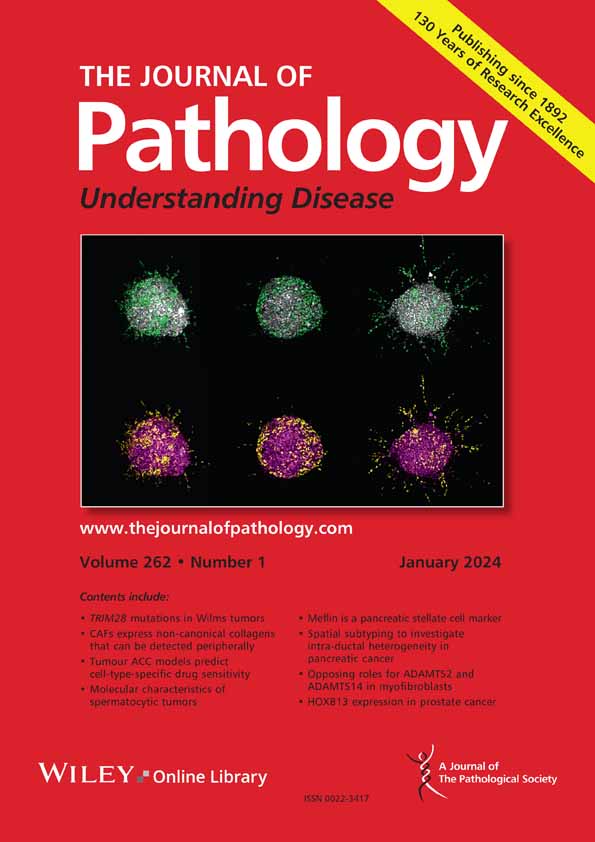Takayuki Niitsu, Toshiaki Kataoka, Kiyoharu Fukushima, Daisuke Motooka, Shigeyuki Shichino, Yayoi Natsume-Kitatani, Hideya Kitamura, Takashi Niwa, Tomohisa Baba, Daisuke Okuzaki, Atsushi Kumanogoh, Shizuo Akira, Koji Okudela, Takashi Ogura
下载PDF
{"title":"Spatial transcriptomics identifies SPARC as a prognostic marker in interstitial lung diseases","authors":"Takayuki Niitsu, Toshiaki Kataoka, Kiyoharu Fukushima, Daisuke Motooka, Shigeyuki Shichino, Yayoi Natsume-Kitatani, Hideya Kitamura, Takashi Niwa, Tomohisa Baba, Daisuke Okuzaki, Atsushi Kumanogoh, Shizuo Akira, Koji Okudela, Takashi Ogura","doi":"10.1002/path.6451","DOIUrl":null,"url":null,"abstract":"<p>Interstitial lung diseases (ILDs) encompass a diverse group of pulmonary disorders, with progressive fibrosis leading to poor prognosis. Here we aimed to identify key molecules involved in progressive fibrosis across various ILDs, using spatial transcriptomics (ST). ST analysis (Visium) was performed on lung cryobiopsy specimens from five patients with various ILDs. Two cases, rich in young fibrotic lesions, as defined by fibroblastic foci and destructive alveolar organization, were selected for spatial high-dimensional weighted gene coexpression network analysis (hdWGCNA) to identify key gene networks with biological significance in active fibrosis. We utilized public single-cell RNA sequencing datasets of various ILDs, performed enrichment analysis and trajectory-based differential expression analysis, and quantified cell–cell communication to evaluate the involvement of the spatially extracted module in fibrosis. Immunohistochemical staining of the extracted molecules was performed. Using hdWGCNA, we identified a distinct gene module (the SM2 module) enriched in young fibrotic lesions. The SM2 module was characterized by distinct features of fibroblast activation that were represented across various lesions. Key hub genes within this module, including <i>COL1A2</i>, <i>COL3A1</i>, <i>COL1A1</i>, and <i>SPARC</i>, formed a robust coexpression network. Immunohistochemical staining showed that SPARC, a component of the SM2 module, was highly expressed in young fibrotic lesions, but not in old scarring lesions, across various ILDs. To assess the prognostic significance of SPARC immunohistochemical expression, we extended our analysis to a cohort of 71 patients with unclassifiable ILDs (uILDs), a particularly heterogeneous subtype with unclear pathogenesis and limited treatment options. Higher SPARC levels in the upper, lower, or both lung lobes in uILD were significantly associated with poor overall survival. In summary, an integrated cross-disease approach using ST revealed key gene expression patterns central to active fibrosis and successfully identified SPARC as a potentially beneficial prognostic marker. © 2025 The Author(s). <i>The Journal of Pathology</i> published by John Wiley & Sons Ltd on behalf of The Pathological Society of Great Britain and Ireland.</p>","PeriodicalId":232,"journal":{"name":"The Journal of Pathology","volume":"267 1","pages":"79-91"},"PeriodicalIF":5.2000,"publicationDate":"2025-07-28","publicationTypes":"Journal Article","fieldsOfStudy":null,"isOpenAccess":false,"openAccessPdf":"https://pathsocjournals.onlinelibrary.wiley.com/doi/epdf/10.1002/path.6451","citationCount":"0","resultStr":null,"platform":"Semanticscholar","paperid":null,"PeriodicalName":"The Journal of Pathology","FirstCategoryId":"3","ListUrlMain":"https://pathsocjournals.onlinelibrary.wiley.com/doi/10.1002/path.6451","RegionNum":2,"RegionCategory":"医学","ArticlePicture":[],"TitleCN":null,"AbstractTextCN":null,"PMCID":null,"EPubDate":"","PubModel":"","JCR":"Q1","JCRName":"ONCOLOGY","Score":null,"Total":0}
引用次数: 0
引用
批量引用
Abstract
Interstitial lung diseases (ILDs) encompass a diverse group of pulmonary disorders, with progressive fibrosis leading to poor prognosis. Here we aimed to identify key molecules involved in progressive fibrosis across various ILDs, using spatial transcriptomics (ST). ST analysis (Visium) was performed on lung cryobiopsy specimens from five patients with various ILDs. Two cases, rich in young fibrotic lesions, as defined by fibroblastic foci and destructive alveolar organization, were selected for spatial high-dimensional weighted gene coexpression network analysis (hdWGCNA) to identify key gene networks with biological significance in active fibrosis. We utilized public single-cell RNA sequencing datasets of various ILDs, performed enrichment analysis and trajectory-based differential expression analysis, and quantified cell–cell communication to evaluate the involvement of the spatially extracted module in fibrosis. Immunohistochemical staining of the extracted molecules was performed. Using hdWGCNA, we identified a distinct gene module (the SM2 module) enriched in young fibrotic lesions. The SM2 module was characterized by distinct features of fibroblast activation that were represented across various lesions. Key hub genes within this module, including COL1A2 , COL3A1 , COL1A1 , and SPARC , formed a robust coexpression network. Immunohistochemical staining showed that SPARC, a component of the SM2 module, was highly expressed in young fibrotic lesions, but not in old scarring lesions, across various ILDs. To assess the prognostic significance of SPARC immunohistochemical expression, we extended our analysis to a cohort of 71 patients with unclassifiable ILDs (uILDs), a particularly heterogeneous subtype with unclear pathogenesis and limited treatment options. Higher SPARC levels in the upper, lower, or both lung lobes in uILD were significantly associated with poor overall survival. In summary, an integrated cross-disease approach using ST revealed key gene expression patterns central to active fibrosis and successfully identified SPARC as a potentially beneficial prognostic marker. © 2025 The Author(s). The Journal of Pathology published by John Wiley & Sons Ltd on behalf of The Pathological Society of Great Britain and Ireland.






 求助内容:
求助内容: 应助结果提醒方式:
应助结果提醒方式:


